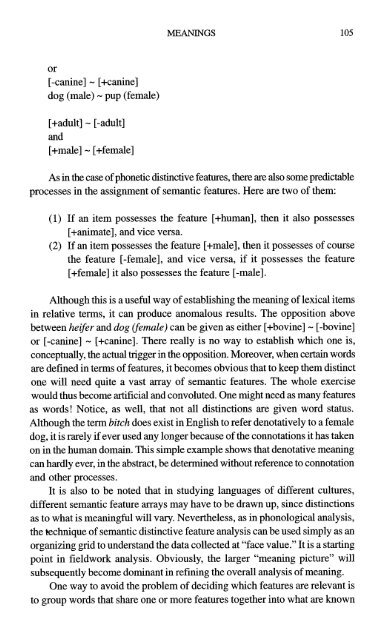A Basic Course in Anthropological Linguistics (Studies in Linguistic ...
A Basic Course in Anthropological Linguistics (Studies in Linguistic ...
A Basic Course in Anthropological Linguistics (Studies in Linguistic ...
You also want an ePaper? Increase the reach of your titles
YUMPU automatically turns print PDFs into web optimized ePapers that Google loves.
or<br />
[-can<strong>in</strong>e] - [+can<strong>in</strong>e]<br />
dog (male) - pup (female)<br />
[+adult] - [-adult]<br />
and<br />
[+male] - [+female]<br />
MEANINGS 105<br />
As <strong>in</strong> the case of phonetic dist<strong>in</strong>ctive features, there are also some predictable<br />
processes <strong>in</strong> the assignment of semantic features. Here are two of them:<br />
(1) If an item possesses the feature [+human], then it also possesses<br />
[+animate], and vice versa.<br />
(2) If an item possesses the feature [+male], then it possesses of course<br />
the feature [-female], and vice versa, if it possesses the feature<br />
[+female] it also possesses the feature [-male].<br />
Although this is a useful way of establish<strong>in</strong>g the mean<strong>in</strong>g of lexical items<br />
<strong>in</strong> relative terms, it can produce anomalous results. The opposition above<br />
between heifer and dog @male) can be given as either [+bov<strong>in</strong>e] - [-bov<strong>in</strong>e]<br />
or [-can<strong>in</strong>e] - [+can<strong>in</strong>e]. There really is no way to establish which one is,<br />
conceptually, the actual trigger <strong>in</strong> the opposition. Moreover, when certa<strong>in</strong> words<br />
are def<strong>in</strong>ed <strong>in</strong> terms of features, it becomes obvious that to keep them dist<strong>in</strong>ct<br />
one will need quite a vast array of semantic features. The whole exercise<br />
would thus become artificial and convoluted. One might need as many features<br />
as words! Notice, as well, that not all dist<strong>in</strong>ctions are given word status.<br />
Although the term bitch does exist <strong>in</strong> English to refer denotatively to a female<br />
dog, it is rarely if ever used any longer because of the connotations it has taken<br />
on <strong>in</strong> the human doma<strong>in</strong>. This simple example shows that denotative mean<strong>in</strong>g<br />
can hardly ever, <strong>in</strong> the abstract, be determ<strong>in</strong>ed without reference to connotation<br />
and other processes.<br />
It is also to be noted that <strong>in</strong> study<strong>in</strong>g languages of different cultures,<br />
different semantic feature arrays may have to be drawn up, s<strong>in</strong>ce dist<strong>in</strong>ctions<br />
as to what is mean<strong>in</strong>gful will vary. Nevertheless, as <strong>in</strong> phonological analysis,<br />
the technique of semantic dist<strong>in</strong>ctive feature analysis can be used simply as an<br />
organiz<strong>in</strong>g grid to understand the data collected at “face value.” It is a start<strong>in</strong>g<br />
po<strong>in</strong>t <strong>in</strong> fieldwork analysis. Obviously, the larger “mean<strong>in</strong>g picture” will<br />
subsequently become dom<strong>in</strong>ant <strong>in</strong> ref<strong>in</strong><strong>in</strong>g the overall analysis of mean<strong>in</strong>g.<br />
One way to avoid the problem of decid<strong>in</strong>g which features are relevant is<br />
to group words that share one or more features together <strong>in</strong>to what are known






